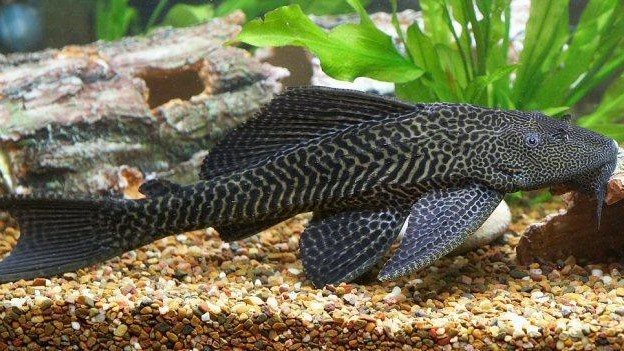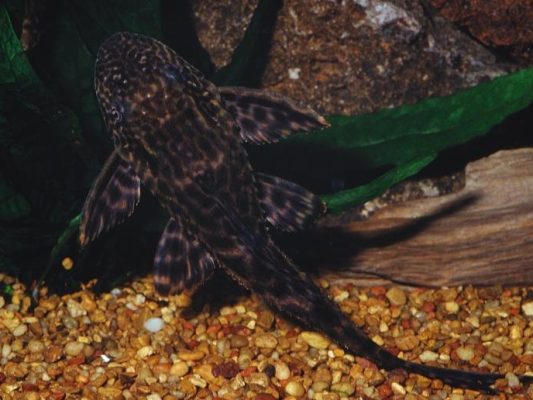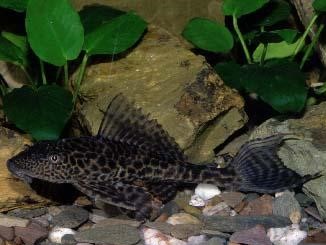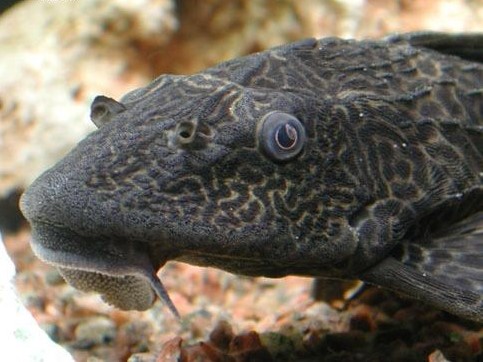Amazon Sailfin Catfish

Table of Contents
Introduction
The Amazon sailfin catfish (Pterygoplichthys pardalis), also known as the sailfin pleco, is a fascinating species native to the Amazon River basin. This unique catfish species is known for its distinctive sail-like dorsal fin and armored body. The sail-like fin, which can be extended or retracted, adds to the catfish’s allure and sets it apart from other species in the region.
Studying and understanding the Amazon sailfin catfish is of utmost importance due to its ecological significance in the Amazon River basin. As a key member of the aquatic ecosystem, this species plays a crucial role in maintaining the balance and health of the river system. By studying its behavior, habitat, and impact on the ecosystem, scientists can gain valuable insights into the intricate web of life in the Amazon.
The catfish’s feeding habits, reproductive behavior, and social interactions can provide valuable information about the functioning of the ecosystem. Additionally, understanding its preferred habitat and the factors that influence its survival can help in assessing the overall health of the Amazon River basin.
In the following sections, we will explore each aspect in detail, providing evidence and expert opinions to offer readers a comprehensive understanding of the Amazon sailfin catfish and its significance in the Amazon River basin.
Physical Characteristics
Description of the Amazon Sailfin Catfish’s Appearance
The Amazon sailfin catfish, scientifically known as Pterygoplichthys pardalis, is a visually striking species with a unique body shape. Its elongated and cylindrical form sets it apart from other catfish species. The body of the Amazon sailfin catfish is covered in bony plates, known as scutes, which provide protection against potential predators and environmental hazards.
These scutes not only serve as a defense mechanism but also contribute to the catfish’s distinctive appearance. The scutes are arranged in rows along the body, creating a textured and armored exterior. This armored plating is particularly prominent along the lateral line, providing additional protection to vital organs.
Discussion of Size, Weight, and Unique Features
The Amazon sailfin catfish exhibits a wide range of sizes, with small juveniles measuring around 4 to 6 inches in length, while large adults can reach impressive sizes of up to 20 inches or more. In some cases, individuals have been reported to exceed 2 feet in length, making them one of the largest catfish species in the Amazon River basin.
When it comes to weight, the average Amazon sailfin catfish weighs around 2 to 3 pounds, but there have been reports of individuals weighing over 10 pounds. This significant size and weight make them not only visually impressive but also formidable inhabitants of their habitat.
One of the most remarkable features of the Amazon sailfin catfish is its sail-like dorsal fin. This fin, located on the upper side of the catfish’s body, can be extended or retracted depending on the catfish’s needs. When extended, the dorsal fin creates an impressive display, resembling a sail, which is believed to play a role in courtship rituals and territorial displays.
Examination of Coloration and Pattern Variations
The Amazon sailfin catfish exhibits a range of colorations, with the most common being dark brown to black. This dark coloration helps the catfish blend in with its surroundings, providing camouflage and protection from potential predators. However, it is worth noting that variations in coloration can occur, with some individuals displaying lighter shades or even mottled patterns.
In addition to coloration, the Amazon sailfin catfish may also exhibit variations in patterns on its body. These patterns can include spots, stripes, or a combination of both. The purpose of these patterns is not yet fully understood, but it is believed that they may serve as additional camouflage or visual cues for communication among individuals.
Overall, the physical characteristics of the Amazon sailfin catfish contribute to its unique and captivating appearance. Its elongated body, bony plates, impressive size, and sail-like dorsal fin make it a visually striking species that stands out in its habitat. Further research and observation are needed to fully understand the function and significance of its coloration and pattern variations.
Habitat
Overview of the natural habitat of the Amazon sailfin catfish
The Amazon sailfin catfish, scientifically known as Pterygoplichthys pardalis, primarily inhabits the freshwater environments of the Amazon River basin. This region, renowned for its rich biodiversity, provides an ideal habitat for the thriving of this species. The catfish exhibits a preference for slow-moving rivers and streams, where it can find abundant food sources and suitable conditions for survival.
One of the remarkable adaptations of the Amazon sailfin catfish is its ability to tolerate various water conditions, including low oxygen levels. This adaptability allows the catfish to inhabit different parts of the river basin, including areas with stagnant or oxygen-deprived water. This unique characteristic enables the species to occupy ecological niches that other fish may find inhospitable.
Discussion of the preferred water conditions and temperature range
The Amazon sailfin catfish thrives in specific water parameters that contribute to its overall health and well-being. The ideal temperature range for this species is between 24°C to 28°C (75°F to 82°F). Within this range, the catfish exhibits optimal physiological functions and metabolic rates.
In terms of water chemistry, the catfish prefers a pH range of 6.5 to 7.5 and moderate water hardness. These conditions closely resemble the natural water chemistry of the Amazon River basin. Maintaining these parameters in captivity is crucial for the successful husbandry of the Amazon sailfin catfish.
It is important to note that drastic fluctuations in temperature, pH, or water hardness can negatively impact the health of the catfish. Sudden changes in these parameters can lead to stress, compromised immune function, and even mortality. Therefore, it is essential for aquarists and researchers to closely monitor and maintain stable water conditions to ensure the well-being of the catfish.
Exploration of the geographical distribution of the species
The Amazon sailfin catfish is predominantly found in the Amazon River and its tributaries, spanning across several South American countries, including Brazil, Peru, and Colombia. Within this vast river system, the catfish occupies various microhabitats, such as flooded forests, oxbow lakes, and slow-moving streams.
In addition to its native range, the Amazon sailfin catfish has been introduced to other regions, including the United States. It is important to note that the introduction of non-native species can have significant ecological consequences. In the case of the Amazon sailfin catfish, its introduction to non-native habitats can disrupt local ecosystems and negatively impact native fish populations.
Efforts are being made to understand the extent of the catfish’s distribution in these introduced regions and to develop strategies for managing its population. It is crucial to prevent further introductions and to implement measures to control and mitigate the potential ecological impacts of this species outside its native range.
In conclusion, the Amazon sailfin catfish is adapted to the freshwater environments of the Amazon River basin, particularly slow-moving rivers and streams. Its ability to tolerate various water conditions, including low oxygen levels, allows it to occupy diverse ecological niches. Maintaining stable water parameters, such as temperature, pH, and water hardness, is essential for the health and well-being of the catfish. While its native distribution is primarily in the Amazon River and its tributaries, efforts are being made to understand and manage its presence in non-native regions. Continued research and conservation efforts are necessary to ensure the long-term sustainability of this fascinating species and its habitat.
Behavior
The behavior of the Amazon sailfin catfish is a fascinating aspect of its biology that contributes to its ecological significance in the Amazon River basin. This section will delve into the feeding habits and diet of the catfish, its reproductive behavior and breeding patterns, as well as its social behavior and interactions with other species.
Analysis of the Amazon sailfin catfish’s feeding habits and diet
The Amazon sailfin catfish is primarily a herbivorous species, with a preference for algae, aquatic plants, and organic matter. Its feeding behavior plays a crucial role in the nutrient cycling within its habitat. By consuming algae and aquatic plants, the catfish helps to control their growth, preventing excessive proliferation that could disrupt the balance of the ecosystem.
Research studies have shown that the catfish actively grazes on submerged vegetation, using its specialized mouthparts to scrape off algae and consume plant matter. This behavior not only provides the catfish with a source of nutrition but also contributes to the overall health of the aquatic environment by reducing the availability of excess nutrients.
Furthermore, the catfish’s feeding habits contribute to the nutrient cycling in its habitat. As it consumes algae and organic matter, it breaks them down into smaller particles, facilitating the decomposition process. This decomposition releases essential nutrients back into the water, which can be utilized by other organisms in the ecosystem. Therefore, the Amazon sailfin catfish plays a crucial role in maintaining the nutrient balance and overall productivity of the Amazon River basin.
Examination of its reproductive behavior and breeding patterns
The reproductive behavior of the Amazon sailfin catfish is a complex and intriguing process. Breeding typically occurs during the rainy season when water levels rise, creating suitable conditions for reproduction. During this time, male catfish construct nests for egg deposition.
The male catfish prepares a nest by clearing a circular depression in the substrate, usually in sandy or muddy areas near the riverbank. The nest is carefully constructed and maintained by the male, who uses his pectoral fins to fan water over the eggs, ensuring proper oxygenation and preventing fungal growth.
Once the nest is ready, the female catfish lays her eggs inside the nest, and the male fertilizes them externally. The number of eggs produced can vary significantly, with larger females capable of producing thousands of eggs in a single breeding event.
After fertilization, the male assumes the role of guarding the nest and protecting the eggs from potential predators. He remains vigilant, fanning water over the eggs to maintain optimal oxygen levels and ward off any threats. This parental care exhibited by the male catfish is crucial for the survival and development of the offspring.
Discussion of its social behavior and interactions with other species
The Amazon sailfin catfish is known for its social behavior, often forming schools or aggregations. These groups can consist of individuals of various sizes, ranging from juveniles to adults. By forming schools, the catfish benefits from increased protection against predators and improved foraging efficiency.
Additionally, the catfish may engage in symbiotic relationships or interactions with other aquatic species. For example, studies have documented the association between the Amazon sailfin catfish and certain species of cleaner fish. These cleaner fish remove parasites and dead skin from the catfish, providing a cleaning service that benefits both parties involved.
Furthermore, the catfish’s presence within the ecosystem can influence the behavior and distribution of other species. For instance, some fish species may exhibit a preference for areas where the catfish is present, as they can take advantage of the food resources made available through the catfish’s feeding habits.
Overall, the behavior of the Amazon sailfin catfish showcases its adaptability and ecological importance within the Amazon River basin. From its herbivorous feeding habits that contribute to nutrient cycling to its complex reproductive behavior and social interactions, the catfish plays a vital role in maintaining the balance and functioning of the ecosystem. Further research into its behavior and interactions with other species will continue to enhance our understanding of this remarkable species and its ecological significance.
Ecological Impact
Evaluation of the Amazon sailfin catfish’s role in the ecosystem
The Amazon sailfin catfish, with its unique characteristics and adaptive behavior, plays a crucial role in the intricate web of the Amazon River basin ecosystem. Occupying a specific ecological niche, this species contributes significantly to the overall balance and functioning of the ecosystem.
One of the key roles of the Amazon sailfin catfish is its contribution to controlling algae growth. As herbivores, these catfish primarily feed on algae and aquatic plants, helping to maintain a healthy balance in the aquatic environment. By consuming excessive algae, they prevent overgrowth, which can lead to oxygen depletion and the degradation of water quality. This control of algae growth is vital for the survival of other aquatic organisms, as it ensures the availability of oxygen and nutrients in the water.
Examination of its feeding habits and potential impact on native species
While the Amazon sailfin catfish plays a beneficial role in controlling algae growth, its feeding habits and potential impact on native fish species require careful consideration. As opportunistic feeders, these catfish can compete with native fish species for food resources, particularly during periods of scarcity.
In some cases, the introduction of the Amazon sailfin catfish into non-native habitats has resulted in negative impacts on native fish populations. Competition for food resources can lead to reduced food availability for native species, potentially affecting their growth, reproduction, and overall population dynamics. It is essential to monitor and assess the interactions between the Amazon sailfin catfish and native species to better understand the potential ecological consequences.
Analysis of its ability to adapt and thrive in different environments
The adaptability of the Amazon sailfin catfish is a remarkable characteristic that has allowed it to establish populations in various environments beyond its native range. This adaptability is evident in its successful establishment in non-native regions, such as the United States, where it has become an invasive species.
The ability of the Amazon sailfin catfish to thrive in different environments poses potential risks to native ecosystems. As an invasive species, it can outcompete native fish species for resources and disrupt the balance of the ecosystem. This can lead to the decline or even extinction of native species, altering the structure and functioning of the ecosystem.
Understanding the potential risks associated with the introduction of the Amazon sailfin catfish to new ecosystems is crucial for effective management and conservation strategies. It is essential to implement measures to prevent the unintentional introduction of this species into non-native habitats and to monitor its presence in areas where it has already been established.
In conclusion, the Amazon sailfin catfish plays a significant role in the Amazon River basin ecosystem. Its contribution to controlling algae growth and its adaptability to various environments highlight its ecological importance. However, careful consideration must be given to its potential impact on native species, especially in non-native habitats. By understanding its ecological role and potential risks, we can develop effective conservation strategies to ensure the long-term sustainability of both the Amazon sailfin catfish and the ecosystems it inhabits.
Conclusion
Throughout this article, we have delved into the fascinating world of the Amazon sailfin catfish, exploring its physical characteristics, habitat, behavior, ecological impact, and conservation efforts. We have learned that this species, native to the Amazon River basin, possesses unique traits such as its sail-like dorsal fin and armored body. Its elongated and cylindrical form, covered in bony plates, provides protection and contributes to its distinct appearance.
In terms of size, the Amazon sailfin catfish exhibits a wide range, with small juveniles growing into large adults. While the average weight of these catfish is noteworthy, it is not uncommon for some individuals to exceed expectations and grow even larger. The sail-like dorsal fin, which can be extended or retracted, adds to the allure of this species.
Furthermore, we have explored the natural habitat of the Amazon sailfin catfish, discovering its preference for freshwater environments, particularly slow-moving rivers and streams. This species has shown remarkable adaptability to various water conditions, including those with low oxygen levels. Understanding the ideal water parameters, such as temperature, pH, and water hardness, is crucial for maintaining the health and well-being of these catfish.
In terms of behavior, we have examined the feeding habits and diet of the Amazon sailfin catfish, finding that it primarily consumes algae, aquatic plants, and organic matter. This catfish plays a vital role in the nutrient cycling of its habitat, contributing to the overall balance of the ecosystem. Additionally, we have explored its reproductive behavior, highlighting the construction of nests for egg deposition and the male’s role in guarding the eggs. The social behavior of the Amazon sailfin catfish, including its tendency to form schools, and any symbiotic relationships or interactions with other aquatic species have also been discussed.
The Amazon sailfin catfish holds significant ecological importance within the Amazon River basin. It occupies a specific niche in the food web, controlling algae growth and contributing to the overall balance of the ecosystem. Its unique characteristics and behaviors make it a species worth studying and understanding.
However, the Amazon sailfin catfish also poses potential risks to native fish species due to competition for food resources. Documented cases have shown negative impacts on native fish populations, underscoring the need for careful management and conservation efforts.
To ensure the long-term survival of the Amazon sailfin catfish and the preservation of its habitat, further research and conservation initiatives are imperative. By studying its behavior, habitat, and ecological impact, we can develop effective strategies for its protection. Collaboration between conservation organizations, researchers, local communities, and authorities is crucial in implementing responsible management practices and safeguarding the species.
As we look to the future, the Amazon sailfin catfish faces both challenges and opportunities. The ongoing destruction of its natural habitat and overfishing pose significant threats to its survival. However, with increased scientific study, public awareness, and the implementation of conservation measures, there is hope for the long-term sustainability of this species.
Further research is needed to gain a deeper understanding of the Amazon sailfin catfish and its complex interactions within the ecosystem. Exploring its genetic diversity, investigating its adaptability to different environments, and assessing the impacts of its introduction to non-native regions are potential areas for future investigation.
In conclusion, the Amazon sailfin catfish is a remarkable species that warrants our attention and conservation efforts. By comprehensively exploring its physical characteristics, habitat, behavior, ecological impact, and conservation initiatives, we can foster a greater understanding of this species and work towards its long-term preservation. Let us continue to champion scientific study, public awareness, and responsible management to ensure the survival of the Amazon sailfin catfish and the preservation of its unique ecosystem.



